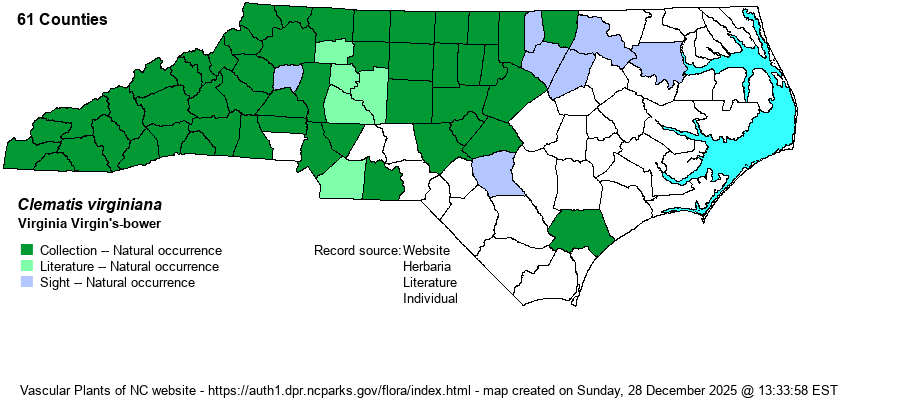| Author | L. | |
| Distribution | Throughout the Mountains, and nearly throughout the Piedmont, but scarce in the southeastern counties. Ranges into the Coastal Plain mainly near the Roanoke and Cape Fear rivers.
This is a widespread Eastern species, ranging from eastern Canada south into central FL and eastern TX, but scarce on the Atlantic Coastal Plain. | |
| Abundance | Common across the Mountains and the northern two-thirds of the Piedmont; rare to uncommon in the southern Piedmont counties, and may be absent in a few along the SC line. Rare into the Coastal Plain along a few large brownwater rivers. | |
| Habitat | This species grows mostly in moist and partly sunny habitats. It grows best over wet or damp thickets and wooded margins, openings in bottomlands (such as bridge crossings), and along marsh edges. It seldom is found in dry habitats, and is not numerous in mesic habitats. |
| Phenology | Blooms from July to September, and fruits shortly after flowering. | |
| Identification | This is a familiar species across the western two-thirds of the state. It is an herbaceous vine that grows to 10 feet or more. It has numerous opposite leaves, each of which is trifoliate, broken into 3 distinct leaflets. Each leaflet has serrated margins and an ovate shape, about 2-3 inches long and about 2 inches wide. The very similar C. catesbyana has a similar form, but normally has 5 leaflets (pinnately arranged), but can have 3. That species has thicker and shinier leaves, and it occurs only along the coast and at a few places in the central mountains where limestone/dolomite crops out at the surface. Each species has numerous flower clusters at leaf axils, with a handful of white flowers consisting of 4-5 oblong sepals, with the spread flower about 1 inch across. These flower clusters are impossible to miss, as many dozens of flowers can be in bloom on a single plant in late summer. After flowering, the "seeds" are attached to a long feathery-plume, the collection of them forming a "curly-head" ball about 2 inches across -- also impossible to overlook! Many a wet thicket or bottomland edge in the mountains and Piedmont has this species draped over the vegetation. Note that the non-native C. terniflora also has similar white flowers and is also numerous across the state; however, it has smooth/entire margins of the leaflets, which thus are rounded and not jagged. | |
| Taxonomic Comments | None
| |
| Other Common Name(s) | Normally just called Virgin's Bower or Virgin's-bower. However, as one or two other species are similar and also named as xxxxx Virgin's-bower, a modifier name is needed. Autumn Clematis, Devil's Darning-needles | |
| State Rank | S5 | |
| Global Rank | G5 | |
| State Status | | |
| US Status | | |
| USACE-agcp | FAC link |
| USACE-emp | FAC link |

